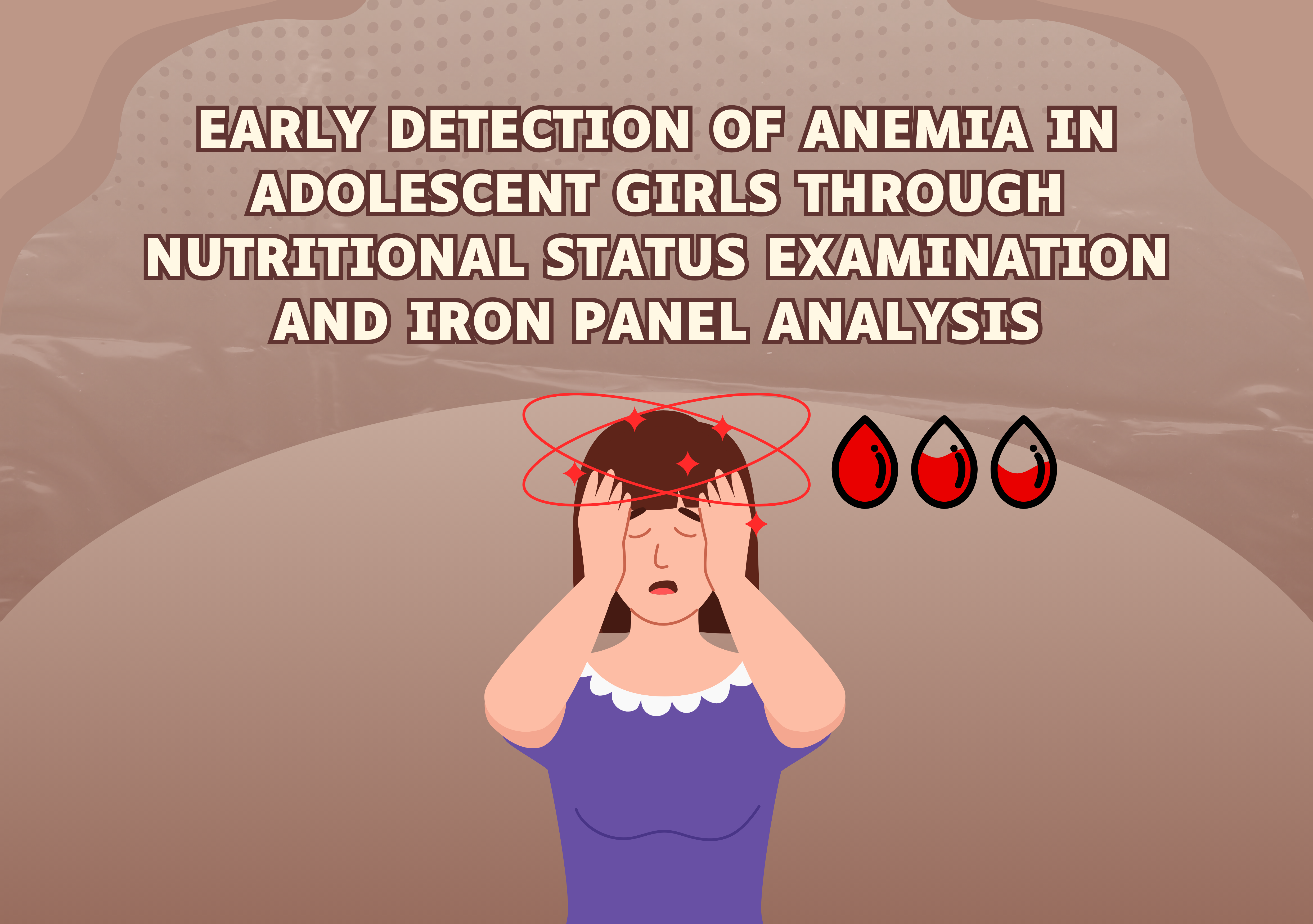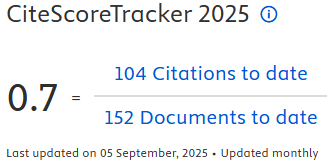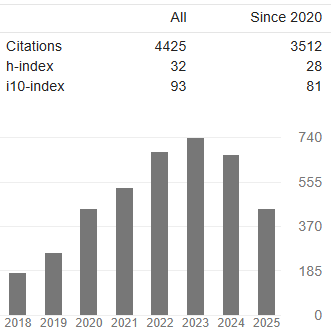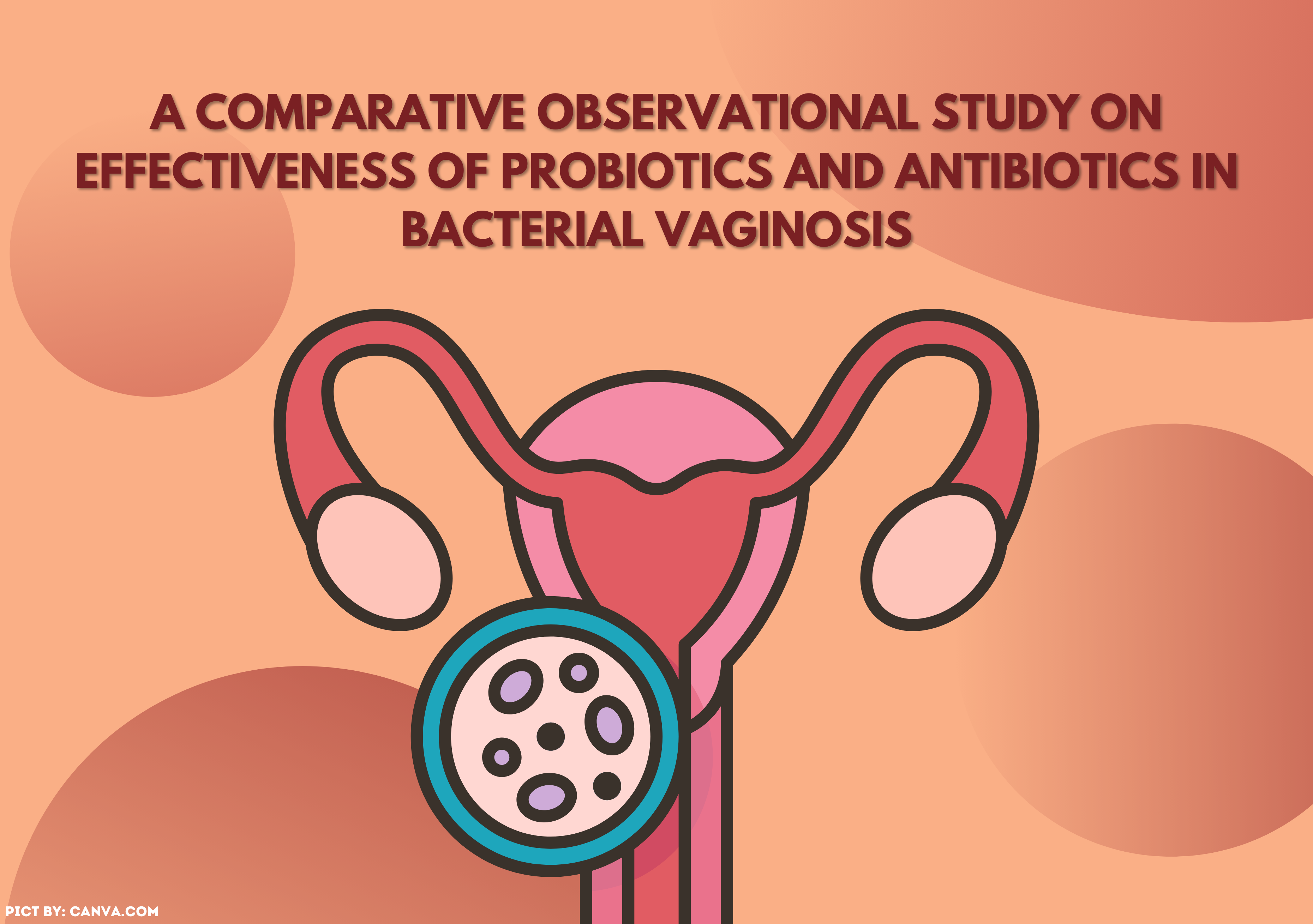EARLY DETECTION OF ANEMIA IN ADOLESCENT GIRLS THROUGH NUTRITIONAL STATUS EXAMINATION AND IRON PANEL ANALYSIS (TIBC, SERUM IRON, IRON SATURATION)

Introduction. The panel iron analysis is an effort made to screen for anemia in adolescent girls. Adolescents with anemia can experience disturbances in growth and development, behavioral changes, and motor disturbances. In Jember district found that on average 30-40% of female students suffer from anemia. Anemia screening is an effort made to maintain the health of adolescents so that they can grow and develop in accordance with their growth and developmental stages. Aims. The purpose of this study is the early detection of anemia in adolescent girls. Methods. This research is an analytical descriptive study with a cross-sectional approach. Data collection was by examining nutritional status and iron panel examination results. The sampling method was accidental, involving 21 female students. The research was conducted in March 2023. Data analysis used frequency distribution. Result. The results showed that some students were undernourished (42.9%) and severely malnourished (4.8%); 18 students (85.7%) were classified as KEK. Meanwhile, from the iron panel analysis, 10 students (47.6%) had abnormal serum iron levels, 6 students (28.6%) had abnormal transferrin saturation levels, and the majority of the respondents, 20 students (95.2%), had normal TIBC. Conclusion. The conclusion from this study is that there are still many adolescent girls, especially in the school environment, who are undernourished to severely malnourished. This result correlates with the iron panel analysis which found that some adolescent girls were diagnosed with iron-deficiency anemia, characterized by a decrease in serum iron, transferrin, and iron reserves levels, accompanied by an increase in the TIBC.
Aini, E.N. (2020) ‘Pemeriksaan kadar hemoglobin dan upaya penanganan anemia pada remaja di smas unggulan bppt darus sholah jember 1', JURNAL IDAMAN, VOLUME 4, NO. 2, OKTOBER 2020 : 77 - 83, 4(2), pp. 77–83.
Astiandani, A. (2015) ‘Hubungan Kejadian Anemia Dengan Prestasi Belajar Matematika Pada Remaja Putri Kelas 11 Di Sman 1 Sedayu', Http://Digilib.Unisayogya.Ac.Id/334/ [Preprint]. Available At: Http://Digilib.Unisayogya.Ac.Id/Id/Eprint/334.
Cholifah, N., Himawan, R. And Menstruasi, S. (2020) ‘Hubungan S Iklus M Enstruasi D An I Ndek M Assa T Ubuh ( I Mt )', 11(2), Pp. 302–307.
Desalegn, A., Mossie, A. And Gedefaw, L. (2014) ‘Nutritional Iron Deficiency Anemia : Magnitude And Its Predictors Among School Age Children , Southwest Ethiopia : A Community Based Cross-Sectional Study', Pp. 1–13. Available At: Https://Doi.Org/10.1371/Journal.Pone.0114059.
Jaelani, M., Simanjuntak, B.Y. And Yuliantini, E. (2015) ‘Faktor Risiko Yang Berhubungan Dengan Kejadian Anemia Pada Remaja Putri', Pp. 358–368.
Kemenkes (2018) Pedoman Pencegahan Dan Penanggulangan Anemia Pada Remaja Putri Dan Wanita Usia Subur (WUS).
Kemenkes RI (2022) Profil Kesehatan Indonesia 2021. Kementerian Kesehatan Republik Indonesia.
Kurniati, I. (2020) Anemia Defisiensi Zat Besi (Fe), JK Unila |.
Melyani And Alexander (2019) ‘Faktor-Faktor Yang Berhubungan Dengan Kejadian Anemia Pada Remaja Putri Di Sekolah Smpn 09 Pontianak Tahun 2019', Jurnal Kebidanan-ISSN 2252-8121 394, 9, Pp. 394–403.
Mirza, F.G. Et Al. (2018) ‘Impact And Management Of Iron Deficiency And Iron Deficiency Anemia In Women's Health', Expert Review Of Hematology, 0(0), P. 1. Available At: Https://Doi.Org/10.1080/17474086.2018.1502081.
Muchtar, F. Et Al. (2022) ‘Pengukuran Status Gizi Remaja Putri Sebagai Upaya Pencegahan Masalah Gizi Di Desa Mekar Kecamatan Soropia Kabupaten Konawe', 4(1), Pp. 43–48.
Muliani, U. (2023) ‘Sosialisasi Resiko Anemia Pada Remaja Putri Di SMA Swadhipa Natar Lampung Selatan Propinsi Lampung', JOMPA ABDI: Jurnal Pengabdian Masyarakat Https://Jurnal.Jomparnd.Com/Index.Php/Jpabdi, 2(2), Pp. 116–121.
Ningrum, N., Setiati, D. And Sari, M. (2023) ‘Diagnosis Dan Tatalaksana Anemia Defisiensi Besi Pada Anak Usia 0 – 18 Tahun', P-ISSN 0853-7720; E-ISSN 2541-4275, Volume 8, Nomor 1, Halaman 99 – 111, Januari 2023 DOI : Https://Doi.Org/10.25105/Pdk.V8i1.15079, 8, Pp. 99–111.
Nurma Astrid Utami, E.F. (2022) ‘Kandungan Zat Besi, Vitamin C Dan Aktivitas Antioksidan Kombinasi Jus Buah Bit Dan Jambu Biji Merah Sebagai Minuman Potensial Penderita Anemia', Indonesian Journal Of Public Health And Nutrition, 2(3), Pp. 372–381.
Rafiqi, A., Matondag, I. And Fevria, R. (2022) ‘Iron Nutrition Anemia ( AGB ) Causes Malnutrition At The Adolescent Level Anemia Gizi Besi ( AGB ) Penyebab Malnutrisi Pada Tingkat Remaja', Prosiding SEMNAS BIO 2022 UIN Syarif Hidayatullah Jakarta ISSN : 2809-8447, Pp. 827–832.
Rahmadi, A. (2013) ‘Perbandinga Pengukuran Lingkar Lengan Atas Dengan Indeks Masa Tubuh Dalam Penentuan Resiko Kurang Energi Kronis Pada Siswi SMA Negeri 4 Kotabumi'. Jurnal Kesehatan Metro Sai Wawai Vol. VI No.2 Edisi Desember 2013.
Rahmadi, A. (2018) ‘Perbedaan Status Anemia Gizi Besi Remaja Putri Yang Bersekolah Di Sma Program Dan Non-Program Suplementasi Tablet Tambah Darah Borneo Journal Of Medical Laboratory Technology', Borneo Journal Ofmedical Laboratorytechnology, 1(1), Pp. 30–34.
Rosalinna, S. (2020) ‘Pengaruh Pola Makan Terhadap Kadar Hemoglobin Pada Anak Pra Sekolah', INTEREST : JURNAL ILMU KESEHATAN, Vol. 9 No.
El Shara, F., Wahid, I. And Semiarti, R. (2017) Hubungan Status Gizi Dengan Kejadian Anemia Pada Remaja Putri Di SMAN 2 Sawahlunto Tahun 2014. Jurnal Kesehatan Andalas. 2017. Available At: Http://Jurnal.Fk.Unand.Ac.Id.
Warner, M.J. And Kamran, M.T. (2023) ‘Iron Deficiency Anemia', National Library Of Medicine [Preprint].
Yunieswati, W. (2014) ‘Status Antropometri Dengan Beberapa Indikator Pada Mahasiswa TPB-IPB', J. Gizi Pangan, 9(November), Pp. 181–186.
Copyright (c) 2024 The Indonesian Journal of Public Health

This work is licensed under a Creative Commons Attribution-NonCommercial-ShareAlike 4.0 International License.
- The authors agree to transfer the transfer copyright of the article to The Indonesian Journal of Public Health effective if and when the paper is accepted for publication.
- Authors and other parties are bound to the Creative Commons Attribution-NonCommercial-ShareAlike 4.0 International License for the published articles, legal formal aspect of journal publication accessibility refers to Creative Commons Attribution-NonCommercial-ShareAlike 4.0 International License (CC BY-NC-SA), implies that:
- Attribution ” You must give appropriate credit, provide a link to the license, and indicate if changes were made. You may do so in any reasonable manner, but not in any way that suggests the licensor endorses you or your use.
- NonCommercial ” You may not use the material for commercial purposes.
- ShareAlike ” If you remix, transform, or build upon the material, you must distribute your contributions under the same license as the original.































